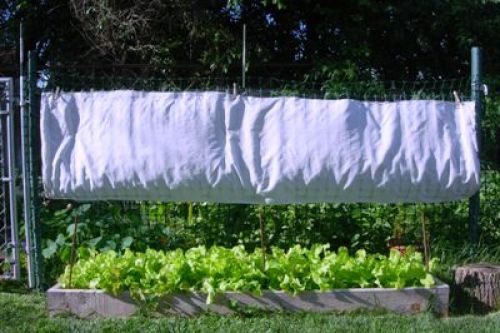Grow Lettuce All Summer Long
Create an inexpensive shade to keep your leafy greens cool during the hottest days of summer

While watching her lettuce droop during a streak of hot Denver weather, it occurred to Kathy Corbett that shading the raised beds might solve the wilting problem. “I decided if I preferred sitting in the shade on hot days, the lettuce would too!” So she constructed an inexpensive shade to keep the sun’s rays off the lettuce. Helping her lettuce keep its cool means Kathy can harvest nice batches of salad greens even on a scorching-hot August day. “The shade protects the lettuce from the sun, and it tends to bolt much more slowly and weaken in the heat much less than it would otherwise,” Kathy says.
The shade is made from a piece of green plastic barrier fence and an old sheet. The plastic fencing provides stability, and the sheet provides protection from the sun. “An old sheet works fine, and the lower the thread count the better, because the fabric is more permeable and lets rainwater through,” she says. “The fabric will let the water through but protect the lettuce from hard rain or hail.”
Kathy uses plastic, spring-type clips to secure the plastic-and-sheet shade onto the garden fence so it can be flipped up for easy access to the lettuce. She removes and rolls up the shade at night (to prevent damage from high winds) and then clips it on again in the morning.

Here are Kathy’s suggestions for constructing a lettuce shade of your own:
- Cut a panel of plastic barrier fencing slightly larger than the lettuce bed but small enough to roll up and remove.
- Cut a panel from a sheet or other white fabric that’s a little smaller than the plastic panel.
- Tack the fabric on at the corners of the plastic fencing and in several spots along the fence edges with a needle and strong thread.
- Use spring-type clips to secure the shade to a fence or other nearby structure. If the lettuce is growing along a wooden fence, install hooks to secure the shade.
- Hang the panel with the fabric side closest to the lettuce; make sure the shade sits several inches above the bed.
- Support the front of the shade with stakes.
- Use clothespins to hold the shade in place on the fence when it’s flipped into the up position.
Kathy says she made the shade with materials she had on hand and cut it to fit the garden’s narrow beds. Similar shades can be constructed using other materials and cut into special shapes and sizes.
“Your lettuce bed may be different,” Kathy says. “Just use your imagination!”
Fine Gardening Recommended Products

The New Organic Grower, 3rd Edition: A Master's Manual of Tools and Techniques for the Home and Market Gardener, 30th Anniversary Edition
Fine Gardening receives a commission for items purchased through links on this site, including Amazon Associates and other affiliate advertising programs.

A.M. Leonard Deluxe Soil Knife & Leather Sheath Combo
Fine Gardening receives a commission for items purchased through links on this site, including Amazon Associates and other affiliate advertising programs.

Gardener's Log Book from NYBG
Fine Gardening receives a commission for items purchased through links on this site, including Amazon Associates and other affiliate advertising programs.






Comments
Log in or create an account to post a comment.
Sign up Log in